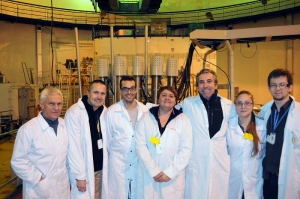The GAMMA MAJOR project accomplished in Świerk
18-12-2015
Main objective of the GAMMA MAJOR project under accomplishment between 2013 and 2015 was to develop a tool capable to determine as accurately as possible amount of heat generated at any selected point of the reactor by gamma radiation. Both JHR and Maria reactors were researched. A software code capable to model the experiment and to numerically recreate results regarding JHR was the subject of an additional project stage. To this end, the codes simulating operation of the latter reactor were in detail analysed and some detailed measurements were conducted on dedicated test facilities developed by Polish and French scientists.
– Joint research projects such as GAMMA MAJOR help to step up our international cooperation – points out Dr. Krzysztof Kurek, NCBJ Director General. – In this case we closely cooperated with University of Marseille and CAE (French government-funded technological research organisation) at each stage of the project – starting from the planning phase to experiments to interpretation of the obtained data.
The just concluded measurements done at the Maria reactor were the last stage of the project. The experiments have fully confirmed effectiveness of the Tripoli4 and Apollo2 French software codes written to simulate the facilities under construction in Cadarache.
Hardware developed in NCBJ for the GAMMA MAJOR project includes a multi-detector probe capable to measure gamma and neutron radiation. The probe is equipped with some innovative instruments: a gamma calorimeter dubbed Karolina (the calorimeter can recreate conditions prevailing inside the Maria reactor), an ionisation chamber, a gamma thermometer, and some self-powered neutron flux density detectors. The hardware was tested in various vertical channels of the MARIA reactor.
– Objectives of the six-day long measurement cycle included to compare efficiency of four new-generation calorimeters (two Polish ones and two French ones), and to measure amount of heat dissipated by gamma radiation absorbed at any given location. To facilitate the measurements we have re-configured the MARIA core. The last stage of the joint project with our French colleagues was exceptional also because an unprecedented number of gauges and instruments were installed at one point. For the first time we tested an innovative calorimeter based on the device installed inside the Osiris reactor, and the upgraded version of the Karolina calorimeter developed in Reactor Analyses & Measurements Team of the NCBJ Research Reactor Technology Division – explained Mikołaj Tarchalski, experiment coordinator appointed by NCBJ. – In view of the fact that the Świerk-developed calorimeter has proven its worth in the last experiment, we hope that it will attract interest of operators of other research reactors and/or other nuclear facilities operated all over the world.
Heat generated by ionizing radiation in various materials placed inside a nuclear reactor is among crucial parameters of that reactor. 90% of the heat is generated in some neutron-induced reactions, the remaining 10% – from absorption of gamma rays emitted during fissions and decays of radioactive nuclei. That proportion depends on location of the point in question: the farther the point is away the core symmetry axis, the more heat comes from gamma absorption. Research on that so-called gamma-heating issue is important for JHR currently under construction in Cadarache. That latter reactor is built to test constructional materials for commercial power reactors.





